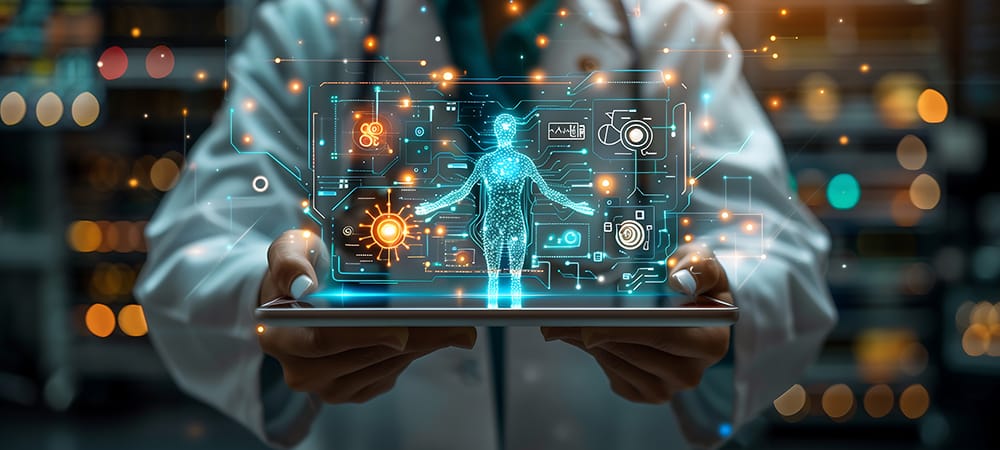Harnessing the Power of AI in Healthcare: Early Diagnosis, Personalised Treatment, and the Role of Edge Computing

Artificial Intelligence (AI) is transforming healthcare in the UK and around the world, bringing new possibilities to disease diagnosis, patient care, and medical research. From reducing diagnostic times to providing personalised treatments, AI is poised to make healthcare more efficient, effective, and accessible. At the core of this transformation is the ability to analyse vast amounts of data in real-time, a feat made achievable and affordable by combining AI with edge computing. This article explores the benefits of AI in healthcare and highlights the role of edge computing in unlocking the full potential of these advanced technologies.
The Benefits of AI in Healthcare: Early Diagnosis and Beyond
1. Early Diagnosis and Disease Detection
One of the most promising applications of AI in healthcare is early diagnosis. Early and accurate diagnosis can make an enormous difference to a patient’s prognosis, particularly for life-threatening diseases like cancer and heart disease. AI models can detect subtle patterns in medical data that might be missed by the human eye, making it possible to identify diseases at an earlier stage.
For instance, AI algorithms are now capable of analysing CT and MRI scans to detect signs of tumours or abnormalities with remarkable precision. A study from Google’s DeepMind project demonstrated that AI could diagnose eye diseases from retinal scans with accuracy comparable to that of leading eye specialists. Another AI model developed by researchers was able to detect signs of lung cancer from CT scans with accuracy rates higher than many radiologists.
This increased precision enables healthcare professionals to intervene earlier, potentially saving lives and reducing the need for more aggressive treatments down the line. With AI-assisted imaging, diagnostic times can be shortened, helping patients receive timely treatment and easing the burden on overstretched NHS services.
2. Personalised Treatment Plans
AI’s ability to handle and analyse extensive data sets is also enabling a more personalised approach to treatment. By examining a patient’s medical history, genetic information, and even lifestyle factors, AI can recommend tailored treatment plans that are better suited to each individual’s needs. This level of precision reduces the likelihood of adverse reactions and improves treatment outcomes.
For example, AI applications in cancer treatment can suggest specific chemotherapy regimens based on tumour characteristics and the patient’s genetic profile. This not only increases the efficacy of the treatment but also reduces the risk of side effects. Such personalised plans can be generated quickly, empowering doctors to make data-informed decisions in real-time, even during consultations.
3. Enhancing Workflow Efficiency
Healthcare facilities face an immense administrative burden, with tasks ranging from appointment scheduling to medical record-keeping. AI-driven systems can streamline these processes by automating repetitive tasks, allowing doctors and nurses to focus more on patient care.
Natural language processing (NLP), a subset of AI, can transcribe and analyse doctors' notes, turning them into structured data that can be easily searched and reviewed, a critical development in an era where so many medical records are yet to be digitised and therefore may not be available to doctors outside of the physical location in which they are stored. Meanwhile, automated scheduling systems can help reduce waiting times, allocate resources more efficiently, and make bed management more responsive to patient needs. By optimising workflow, AI not only reduces operational costs but also improves the overall patient experience.
4. Remote Patient Monitoring and Telemedicine
During Covid the use of telemedicine increased dramatically, which in turn increased access to healthcare, especially in rural and underserved areas. As a result, AI-enabled remote monitoring devices and health apps now allow patients to check in with their doctors from home. Patients with chronic conditions like diabetes or hypertension, for example, can use wearable devices that continuously monitor vital signs and send alerts when irregularities occur. The adoption of this technology now allows clinicians to intervene earlier and make adjustments to the treatment plan remotely, reducing hospital admissions.
The Role of Edge Computing in AI-Driven Healthcare
The success of AI applications in healthcare often hinges on one key factor: the ability to process data quickly and cost-effectively. Edge computing plays a crucial role in this by enabling data processing close to the source, such as within a hospital or even directly on a medical device. This means that CT, MRI, and other imaging data can be analysed locally rather than sent to a centralised cloud server, which would involve delays, potential data security issues, and vast amounts of data transit which may otherwise prove too expensive for already stretched healthcare budgets to implement.
1. Real-Time Processing of Large Datasets
AI models in healthcare often rely on enormous datasets, especially for imaging-based diagnostics. CT and MRI scans produce large volumes of data, which can be time-consuming and expensive to process in a traditional cloud computing environment. Edge computing allows these images to be processed in real-time, directly within the healthcare facility or on-site device. This means that AI-powered diagnostic tools can deliver results immediately, a critical factor when diagnosing life-threatening conditions.
For example, an edge computing-enabled AI device could analyse an MRI scan as soon as it’s captured, providing the doctor with an instant diagnosis or risk assessment. This capability not only saves valuable time but also drastically reduces the costs associated with centralised data processing.
2. Lower Latency and Improved Patient Care
For healthcare applications that require instant feedback, such as remote patient monitoring or emergency diagnostics, latency can be a critical barrier. When data is processed locally through edge computing, the delay is virtually eliminated, allowing medical professionals to respond to health issues in real-time. In critical care situations, such as monitoring vital signs in intensive care units (ICUs), this quick response can be life-saving.
Wearable devices and IoT-enabled health monitors can take advantage of edge computing to process patient data locally and alert healthcare providers to any irregularities immediately. In this way, edge computing ensures continuous, uninterrupted patient monitoring without the delays that might occur with a centralised system.
3. Enhanced Data Security and Compliance
Healthcare data is highly sensitive, and data privacy is of utmost importance. Edge computing mitigates many of the security risks associated with data transfer by keeping patient data on local networks. Instead of sending personal health information over the internet to a centralised cloud server, data can be processed and stored securely at the edge, reducing the risk of breaches.
This localised approach also supports compliance with stringent healthcare regulations, such as the General Data Protection Regulation (GDPR) in the UK and Europe. For healthcare providers, edge computing offers a way to deploy AI systems without compromising data security or violating regulatory standards.
Realising the Future of AI-Powered Healthcare
By combining the analytical power of AI with the speed and security of edge computing, healthcare providers can deliver more accurate, efficient, and personalised care. The ability to process CT and MRI scan data instantly and at a lower cost allows hospitals to make cutting-edge diagnostic tools more widely available, particularly beneficial in the NHS, where resources are often stretched thin.
Looking to the future, we can expect to see even greater collaboration between AI and edge computing in healthcare. As these technologies evolve, we will likely see a broader rollout of AI-driven diagnostic tools in clinics, hospitals, and even remote locations, making high-quality care accessible to more people. From faster, more accurate diagnoses to real-time monitoring, AI and edge computing are poised to create a more cost-effective and efficient healthcare system for everyone.
In conclusion, AI and edge computing are reshaping healthcare by making early diagnosis, personalised treatment, and efficient care delivery possible on an unprecedented scale. By bringing these advanced technologies closer to patients, the NHS and other healthcare providers can offer faster, safer, and more cost-effective care. The future of healthcare is indeed bright, with AI and edge computing at its core.




